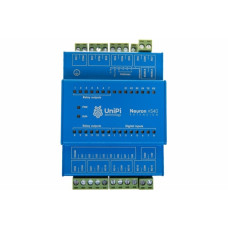UniPi Neuron Extension xS40
The UniPi Extension line of extension modules was designed as a quick and inexpensive way to extend the automation network by additional inputs/outputs without the need to purchase another PLC. Modules are not equipped with a computing module, which is replaced by an additional I/O board. Computing module is represented by a master PLC to which the module is connected via RS485 serial interface.
The xS40 module combines digital inputs and relay outputs. Compared to the xS10 module with the same I/O combination the xS40 offers more relay outputs and less digital inputs. The module is thus suitable for switching two-state devices based on data collected by digital inputs.
Basic Features
| Digital inputs | 8 | Common features RS485 serial interface (Modbus RTU) Aluminium chassis (IP20) Power supply: 24V DC, 0.63/1.5A |
| Relay outputs | 14 | |
| RS485 serial interface | 1 |
Inputs & Outputs Description
Digital inputs (DI) are designed to read binary logic states represented by direct voltage levels. That makes them suitable for reading data from various binary sensors and devices such as switches (on/off), motion sensors (movement detected/not detected), liquid level sensors (full tank/empty tank) etc. All digital inputs also feature counter functionality by default.
Relay outputs (RO) are primarily used for switching two-state devices with higher current draw such as lightbulbs, thermoelectric valve drives, water heaters, pumps etc.
Communication Interfaces
Extension modules communicate through the RS485 interface (Modbus protocol). Connection manual for extension modules can be found on this link
Additional Functionality
Along with standard I/O functionality, the module offers several functions to enhance the module's performance and to allow it to react to critical events.
Digital inputs feature Direct Switch functions allowing for connecting digital inputs with relay outputs. Direct Switch can be configured for one of three modes: Copy (switching output by active input), Invert (output is switched by inactive input) and Toggle (output is switched by each input change). Direct Switch is independent of the control software and is thus suitable for applications demanding a lowest possible response time (such as lighting control).
The default setting is a function allowing each processor to save its default configuration. This configuration is loaded after every device reboot triggered either by a manual restart or by a power outage.
MasterWatchdog feature monitors the communication between CPU and I/O board processors. If no exchange occurs within a pre-set timeframe, the MasterWatchdog automatically resets the device and me/O modules back into default settings.
I/O boards of the module feature their own control processor, which retains the basic I/O functionality in the case of PLC downtime or connection failure.
Device addressing and DIP switch setting
Addressing the extension module can be done either via control software running on the remote master control unit or can be set manually via the integrated DIP switch. The DIP switch allows the user to set up to 4 bits of address and is evaluated in preference to software settings. If the address on DIP switch is set to “0000”, all DIP switch settings are ignored and the software settings take priority.
Package contents
- extension module
- removable screw terminals
- DIN rail holder (35 mm)
- 2× DIN rail holder mounting screws
- 1× grounding screw
Enter the code in the box below:











